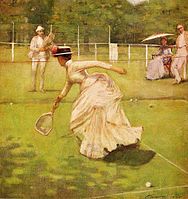The Races at Longchamp
The Longchamp Racecourse was opened in 1857, and is located on the banks of the Seine near Bois de Boulogne. It is still regarded as one of the top thoroughbred racetracks in the world today. In 1867, Edouard Manet, a keen spectator, immortalized this racecourse in The Races at Longchamp. The painting depicts horses thundering down the fence lined track, neck and neck, creating clouds of dust as hundreds of spectators watch on. Manet has created motion in his painting by blurring the heads of the crowd as they turn to follow the horses, showing that the race is fast.
The Football Players
Henri Rousseau had a characteristic ability to paint pictures that were simultaneously beautiful and ludicrous. His 1908 painting, The Football Players show his inability to paint hands and feet accurately, how to show bent knees or creased jerseys around the players’ elbows create the ridiculousness of the painting, but the colors and faces of the players allow the joy prominent. The setting of the painting, although fantastical, is also absurd. Set in the clearing of a forest, the players would find it next to impossible to play on that surface in the space provided, but it was still a good place to go bet with Sports Betting Canada, why not ?!
Pulcinella and the Tumblers
Painted al fresco by Giovanni Tiepolo in 1797, these traveling gymnasts are performing in Venice. Pulcinella is the hook-nosed joker in a black mask, a commedia dell’arte figure that is responsible for turning the whole world upside down. The gymnasts in front of him are enacting this using their contortionist athleticism. Tiepolo’s depictions show the agility of the gymnasts, showing them walking on their hands as they tumble around, while still maintaining their balance.
The Biglin Brothers Turning the Stake
In 1873, Thomas Eakins created this glowing painting to commemorate the first pair-oared sculling race to ever happen in the United States. The picture depicts the Biglin brothers rowing on the Schuylkill River in Philadelphia, with John pushing his oar, and Barney pulling his. The brothers are winning the race, as can be seen by their opponents still approaching their flag in the background.
A Rally

Stories say that Major Walter Clopton Winfield began playing outdoors with rubber balls, creating what is now known as lawn tennis. In 1885, Sir John Lavery, an Irish-born painter, painted this scene of a lady in an incredibly impractical albeit beautiful dress playing lawn tennis, emphasizing her energy and attentiveness, and not just her beauty and femininity. Lavery painted many tennis pictures in Scotland, all of which are considered pioneering, much like the young lady in the painting.
Dynamism of a Cyclist
Umberto Boccioni is an artist that can truly capture the movement of a cyclist, head down, knees pumping, wheels spinning, as he races at amazing speeds. Most two-dimensional pictures are limited when trying to convey motion, but that was unacceptable to futuristic artists in Italy. Boccioni was one of those artists, and arguably the best of them. He adopted the same style as Etienne-Jules Marey, a French photographer, who used pioneering techniques to capture split-second shots of running soldiers, fundamentally capturing images of the past, present, and future in one instant. Dynamism of a Cyclist is a series of overlapping stop-start moment, creating discernable motion.
The Discobolus
One of the most distinguishable pieces of sport art, The Discobolus encapsulates the moment before the athlete releases the discus, when all of his physical strength is being drawn upon. This marble statue is a Roman replica of the lost bronze original, attributed to Myron, a sculptor in about 470-440 BC. Discus was the first part of the pentathlon, and is considered a feat of refinement as well as athleticism. This copy has the head incorrectly turning away from the discus.



